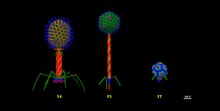
Back فيروسات ذنبية Arabic فيروسات ذنبيه ARZ Caudoviricetes German Caudoviricetes Spanish Caudovirales French Caudovirales FRR Caudovirales Interlingua Caudovirales Italian カウドウイルス Japanese Caudovirales Portuguese
| Caudoviricetes | |
|---|---|

| |
| Order Caudovirales. Structures of T Bacteriophages representing the seven T types of Escherichia coli phages described by Max Delbruck in the 1940s. T4 of the Myoviridae family, T5 of the Siphoviridae family, and T7 of the Podoviridae family. The structures were built from individual protein data bank (pdb) files in the UCSF Chimera software, which were updated to the year 2024 and at real scale. | |
| Virus classification | |
| (unranked): | Virus |
| Realm: | Duplodnaviria |
| Kingdom: | Heunggongvirae |
| Phylum: | Uroviricota |
| Class: | Caudoviricetes |
| Subdivisions | |



Caudoviricetes is a class of viruses known as the tailed bacteriophages (cauda is Latin for "tail").[1] Under the Baltimore classification scheme, the Caudoviricetes are group I viruses as they have double stranded DNA (dsDNA) genomes, which can be anywhere from 18,000 base pairs to 500,000 base pairs in length.[2] The virus particles have a distinct shape; each virion has an icosahedral head that contains the viral genome, and is attached to a flexible tail by a connector protein.[2] The order encompasses a wide range of viruses, many containing genes of similar nucleotide sequence and function. However, some tailed bacteriophage genomes can vary quite significantly in nucleotide sequence, even among the same genus. Due to their characteristic structure and possession of potentially homologous genes, it is believed these bacteriophages possess a common origin.[2]
There are 4 orders, 47 families, 98 subfamilies, 1197 genera, 3601 species in the class. This makes Caudoviricetes the most populous class among viruses, accounting for approximately 30% of all recognized virus species and nearly half of all virus genera.[3]
- ^ Ackermann HW (1998). Tailed bacteriophages: the order caudovirales. Vol. 51. pp. 135–201. doi:10.1016/S0065-3527(08)60785-X. ISBN 9780120398515. PMC 7173057. PMID 9891587.
{{cite book}}:|journal=ignored (help) - ^ a b c "Double-Stranded DNA Bacteriophages". Boundless. 2017-11-11. Archived from the original on 2013-06-28.
- ^ "Virus Taxonomy: 2022 Release". International Committee on Taxonomy of Viruses (ICTV). March 2023. Retrieved 5 November 2023.